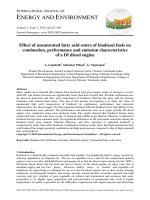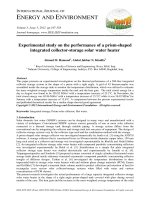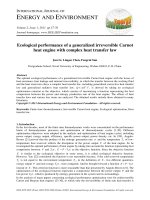fate of a broken space elevator
Bạn đang xem bản rút gọn của tài liệu. Xem và tải ngay bản đầy đủ của tài liệu tại đây (385.77 KB, 21 trang )
Fate of a Broken Space
Elevator
Blaise Gassend
Space Exploration 2005 — April 3-6 2005
Blaise Gassend — Computer Science and Artificial Intelligence Laboratory
Some Previous Work
Some Previous Work
•
Tower of Babel
Tower of Babel
–
Don't mix inches and meters.
•
Kim Stanley Robinson's Red Mars
Kim Stanley Robinson's Red Mars
–
Falling space elevator is a cataclysmic event.
–
Wraps around Mars multiple times.
–
Hits hard, with destructive violence.
•
Dr. Bradley Edwards
Dr. Bradley Edwards
–
Broken ribbon flutters to the ground or burns up.
–
Top fragment might be reattachable.
Space Exploration 2005 — April 3-6 2005
Blaise Gassend — Computer Science and Artificial Intelligence Laboratory
Single Break Model
Single Break Model
•
We consider a failure where the elevator breaks at a
We consider a failure where the elevator breaks at a
single place
single place
.
.
•
Two fragments
Two fragments
result, we study each one
result, we study each one
independently.
independently.
Top fragmentBottom fragment
Space Exploration 2005 — April 3-6 2005
Blaise Gassend — Computer Science and Artificial Intelligence Laboratory
The Simulator
The Simulator
•
Ribbon:
Ribbon:
strength 130 GPa, Young’s modulus 1 TPa,
strength 130 GPa, Young’s modulus 1 TPa,
density 1300 kg/m
density 1300 kg/m
2
2
, uniform stress of 65 GPa.
, uniform stress of 65 GPa.
•
Breaks:
Breaks:
if strength exceeded or reenters too fast.
if strength exceeded or reenters too fast.
•
Simulation:
Simulation:
written in C, rotating reference frame,
written in C, rotating reference frame,
100 masses and springs, forward Euler integration,
100 masses and springs, forward Euler integration,
1 s time step, heavy longitudinal damping.
1 s time step, heavy longitudinal damping.
Space Exploration 2005 — April 3-6 2005
Blaise Gassend — Computer Science and Artificial Intelligence Laboratory
Outline
Outline
Introduction
Introduction
•
Top Fragment
Top Fragment
•
Bottom Fragment
Bottom Fragment
•
Simulations
•
Reentry Modeling
•
Effect on Ground-Based Assets
•
Collisions in Space
Collisions in Space
Space Exploration 2005 — April 3-6 2005
Blaise Gassend — Computer Science and Artificial Intelligence Laboratory
The Top Portion Escapes
The Top Portion Escapes
•
The top fragment of the
The top fragment of the
elevator always
elevator always
escapes
escapes
from the Earth
from the Earth
.
.
•
Recovery
Recovery
seems
seems
very
very
improbable.
improbable.
Space Exploration 2005 — April 3-6 2005
Blaise Gassend — Computer Science and Artificial Intelligence Laboratory
Effect of a Climber
Effect of a Climber
•
Even with a climber
Even with a climber
at its base, the top fragment
at its base, the top fragment
escapes
escapes
.
.
•
Moving climbers around
Moving climbers around
will not help
will not help
.
.
Without Climber With Climber
Space Exploration 2005 — April 3-6 2005
Blaise Gassend — Computer Science and Artificial Intelligence Laboratory
Stability of Unanchored
Stability of Unanchored
Space Elevator
Space Elevator
•
Arnold and Lorenzini (1987):
Arnold and Lorenzini (1987):
A long enough
A long enough
dumbbell tether has
dumbbell tether has
positive orbital energy
positive orbital energy
and is
and is
unstable.
unstable.
•
Steindl and Troger (2005):
Steindl and Troger (2005):
A geo-synchronous sky
A geo-synchronous sky
hook is unstable.
hook is unstable.
•
Impact for space elevator:
Impact for space elevator:
–
When elevator is anchored, there is no stability problem.
–
Risk of stability problems when you are finished deploying
but before you anchor?
–
Deployment increases stability.
–
How fast do you need to deploy to be stable?
Space Exploration 2005 — April 3-6 2005
Blaise Gassend — Computer Science and Artificial Intelligence Laboratory
Outline
Outline
Introduction
Introduction
Top Fragment
Top Fragment
•
Bottom Fragment
Bottom Fragment
•
Simulations
•
Reentry Modeling
•
Effect on Ground-Based Assets
•
Collisions in Space
Collisions in Space
Space Exploration 2005 — April 3-6 2005
Blaise Gassend — Computer Science and Artificial Intelligence Laboratory
Low Breaks
Low Breaks
•
Most likely case (LEO).
Most likely case (LEO).
•
Minimal Coriolis effect. Falls straight down.
Minimal Coriolis effect. Falls straight down.
•
Some burnup on reentry.
Some burnup on reentry.
Cut 10% up Cut 20% up
Space Exploration 2005 — April 3-6 2005
Blaise Gassend — Computer Science and Artificial Intelligence Laboratory
•
Significant
Significant
wrapping
wrapping
around Earth.
around Earth.
•
Burn-up
Burn-up
can cause fragments to be
can cause fragments to be
flung away
flung away
.
.
•
Example of
Example of
long lived fragment
long lived fragment
in 30% case.
in 30% case.
Breaks near GEO
Breaks near GEO
Cut 30% up Cut 40% up
Space Exploration 2005 — April 3-6 2005
Blaise Gassend — Computer Science and Artificial Intelligence Laboratory
Higher…
Higher…
•
Centrifugal force
Centrifugal force
causes first break now.
causes first break now.
•
Tip of ribbon
Tip of ribbon
whips around
whips around
sporadically.
sporadically.
Cut 50% up Cut 60% up
Space Exploration 2005 — April 3-6 2005
Blaise Gassend — Computer Science and Artificial Intelligence Laboratory
Near the tip
Near the tip
•
Wraps all the way around the Earth.
Wraps all the way around the Earth.
•
Overall
Overall
small fraction
small fraction
of ribbon burns up
of ribbon burns up
–
Worst case for break 30% up ribbon.
Cut 80% up Cut 100% up
Space Exploration 2005 — April 3-6 2005
Blaise Gassend — Computer Science and Artificial Intelligence Laboratory
Reentry Modeling
Reentry Modeling
•
Based on models for
Based on models for
meteoroids.
meteoroids.
–
Jones and Kaiser (1966)
•
Ribbon threads are
Ribbon threads are
very thin
very thin
(10 m).μ
(10 m).μ
–
No thermal mass
–
Uniform thread temperature
•
No ablation for slow enough
No ablation for slow enough
reentry.
reentry.
–
Assume ribbon ablates at 600 K.
–
Limit velocity ≈ 5 km/s.
Atmospheric
Friction
Radiation
Velocity
Space Exploration 2005 — April 3-6 2005
Blaise Gassend — Computer Science and Artificial Intelligence Laboratory
Terminal Velocity
Terminal Velocity
•
Simulation
Simulation
shows situ-
shows situ-
ation at
ation at
start of reentry
start of reentry
.
.
•
After initial reentry, slows
After initial reentry, slows
to terminal velocity.
to terminal velocity.
–
10 m/s at 43 km
–
0.5m/s at ground level
⇒
Impact
Impact
of elevator is
of elevator is
leisurely
leisurely
.
.
Gravity Curvature
Atmospheric
Friction
Tension
Tension
Space Exploration 2005 — April 3-6 2005
Blaise Gassend — Computer Science and Artificial Intelligence Laboratory
Force on Ground Object
Force on Ground Object
•
Once ribbon reaches ground, only curvature force
Once ribbon reaches ground, only curvature force
can be large.
can be large.
–
Worst case for large building with clear path to horizon.
–
Force arises from change in direction of tension.
–
For 20 T elevator:
•
What about
What about
slipping/
slipping/
sawing
sawing
?
?
Tension
Tension
Building
Heigh
Heigh
t
t
Force
Force
Force/Widt
Force/Widt
h
h
1 m
1 m
1.1
1.1
kN
kN
1 kN/m
1 kN/m
100 m
100 m
11
11
kN
kN
10 kN/m
10 kN/m
Space Exploration 2005 — April 3-6 2005
Blaise Gassend — Computer Science and Artificial Intelligence Laboratory
Outline
Outline
Introduction
Introduction
Top Fragment
Top Fragment
Bottom Fragment
Bottom Fragment
Simulations
Reentry Modeling
Effect on Ground-Based Assets
•
Collisions in Space
Collisions in Space
Space Exploration 2005 — April 3-6 2005
Blaise Gassend — Computer Science and Artificial Intelligence Laboratory
Collisions in Space
Collisions in Space
•
Fragment with Satellite
Fragment with Satellite
–
Small collision cross-
section.
–
Comparable risk to
normal operations
except GEO satellites.
•
Fragment with Elevator
Fragment with Elevator
–
Large collision cross-
section.
–
Significant risk during
limited period of time.
•
Assume any collision is bad.
Assume any collision is bad.
•
Usually small risk window
Usually small risk window
–
A few hours for top fragment.
–
A day for bottom fragment.
θ
Space Exploration 2005 — April 3-6 2005
Blaise Gassend — Computer Science and Artificial Intelligence Laboratory
Limiting Risk to Elevators
Limiting Risk to Elevators
•
Only ever deploy a single space elevator
Only ever deploy a single space elevator
–
Allows rolled up elevators to be in space for recovery.
–
Not a very compelling solution in the long term.
•
Space out elevators by 90 degrees of longitude
Space out elevators by 90 degrees of longitude
–
Works for low-altitude breaks.
–
At most 4 elevators.
•
Move off equator if break occurs
Move off equator if break occurs
–
Needs detailed study to confirm reliability.
Space Exploration 2005 — April 3-6 2005
Blaise Gassend — Computer Science and Artificial Intelligence Laboratory
Conclusion
Conclusion
•
Confirms Brad Edwards’ reassuring views.
Confirms Brad Edwards’ reassuring views.
–
Falling ribbon poses no mechanical threat at ground level.
–
Smaller risk of elevator fratricide than feared.
•
Some surprises
Some surprises
–
Recovery of top fragment is not an option.
–
Less ribbon than expected burns up.
•
Future work
Future work
–
Look into stability issues for unanchored ribbon.
–
Better models for the simulation.
Space Exploration 2005 — April 3-6 2005
Blaise Gassend — Computer Science and Artificial Intelligence Laboratory
Questions?
Questions?
Contacting me:
Contacting me:
•
Email:
Email:
•
Telephone
Telephone
(617) 253-4334
(617) 253-4334









